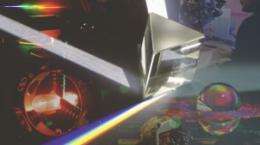Light at the speed of a bicycle and much more

The speed of light, 300 million metres per second, was long thought an immutable constant and has defined our understanding of matter and energy but recent research in the area of optics and photonics is proving that we can manipulate light to some ingenious and hugely lucrative ends.
From the use of adaptive optics to catch perfect images of distant galaxies or detailed representations inside bio-specimens of, for example, mouse embryos, to electromagnetically induced transparency which can slow light to the speed of a bicycle - the field of optics and photonics is in the scientific vanguard.
The Institute of Physics (IOP) and the Engineering and Physical Sciences Research Council (EPSRC) are launching a new report today, Wednesday, 9 September, entitled Optics and photonics: Physics enhancing our lives, to highlight the most recent advances in the field and demonstrate the potentially lucrative ends a range of researchers have in sight.
This field of research has already had a revolutionary effect on all of our everyday lives. From optical fibres, hair-like strands of silica glass that transmit vast amounts of data around the world as fleeting pulses of light, to lasers built in to our CD and DVD players, much of the developed world's technological infrastructure is already structured on physicists' ability to play with light.
There is however still much more to come. Just one of the research areas highlighted in the report, plasmonics, shows how our understanding of light, in this case stemming from the way light interacts with silver and gold to give off a shiny sparkle, could lead to the development of metamaterial-based invisibility cloaks or super-strength solar cells for renewable energy generation.
Advances will have dramatic effects on technology used in security as, for example, iris recognition systems become more sophisticated; communications will become swifter and securer; medical imaging techniques will become more precise; and we will be able to manipulate the plentiful energy of the Sun to greater human benefit.
Dr Robert Kirby-Harris, chief executive at the Institute of Physics, said, "We hope that this booklet illustrates how the research investment made by the EPSRC, and the support provided by the Institute to its membership, will enable the UK economy, and society at large, to benefit from the discoveries and advances being made in leading-edge physics research."
Source: Institute of Physics















